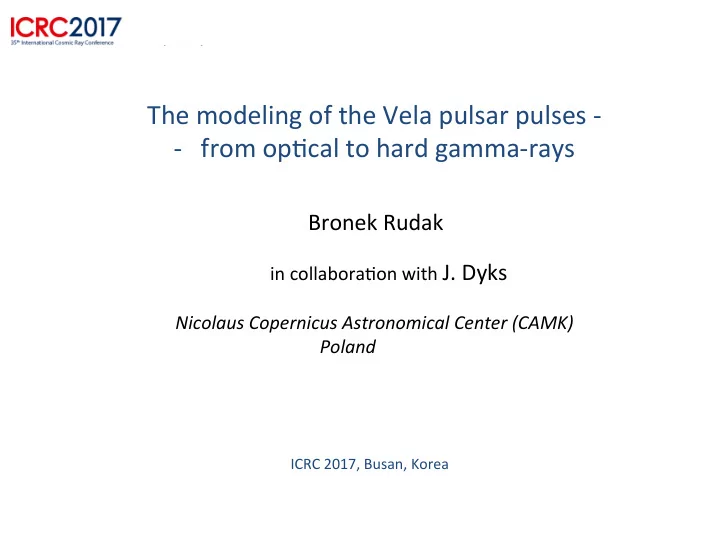

The modeling of the Vela pulsar pulses - - from op5cal to hard gamma-rays Bronek Rudak in collabora5on with J. Dyks Nicolaus Copernicus Astronomical Center (CAMK) Poland ICRC 2017, Busan, Korea
In the talk 1) 3D Outer-Gap model of Very-High-Energy emission expected from Vela-like pulsars: − the origin of the VHE component, − its temporal (pulses) and spectral proper5es. 2) A case for coexistence of the outer gap and an inner gap in the magnetosphere of the Vela pulsar: − the forma5on of core-like pulses in op5cal, UV and in hard X-rays, aligned in phase with the core-like radio pulse (as observed)
The many faces of the Vela pulsar CTA ? 3
Picture from Benoit CeruW 4
μ B Secondary pairs layer: ϒ ~ 100 – 1000, synchrotron photons in op5cal-IR Core emission in coherent radio Outer gap: primary pairs with ϒ > 10 7 , Inner-Gap pairs, curvature photons ϒ ~ 100 - 1000 in gamma Hot surface, T BB = 10 6 K Not to scale drawing 5
Processes Results 1. Primary OG pairs + op5cal-IR photons pulsed VHE component (synchrotron photons) 2. Inner Gap pairs + op5cal-IR photons pulsed core op5cal comp. (synchrotron photons) 3. Inner Gap pairs + thermal X-ray photons pulsed core hard X-rays comp. 6
The first step: determine α − inclina5on angle (between Ω and μ ) and ζ − viewing angle (between Ω and k observer ) by reconstruc5ng simultaneously the shapes and phases of the observed main peaks in op5cal and gamma using the „geometrical” version of the OG model. The next step: use α and ζ in the physical OG model.
Gouiffes 1998 Abdo+ 2010 P1 P2 P1 P2 P3 Two main pulses from Vela in op5cal and gamma rays and their reconstruc5on in a uniform-emissivity version of the OG model, obtained for inclina5on angle α = 70 o , viewing angle ζ = 79 o 8
The OG model - ICS component in VHE α = 70 o 9
Phase-averaged gamma-ray SED in OG model of Vela α = 70 o , ζ = 79 o ICS component: con5nuous – sok photon field op5cal to far-IR dashed – sok photon field op5cal to near-IR Curvature radia5on component CTA South 50h 10
The ICS core component in op5cal-UV α = 70 o P3 -1.0 -0.5 0.0 0.5 1.0
The ICS core component in hard X-rays α = 70 o
Summary 1) The VHE domain − Forma5on of pulsed VHE-spectral component is possible in the Vela pulsar in the case of high inclina5on angle, − its lightcurve consists of two pulses at phases ~0.2 and ~0.6, − its expected phase-averaged flux may be of interest to CTA South (for > 50h). 2) The opFcal-UV and the hard X-rays domains If an inner gap with e - -e + pairs coexists with outer gaps, then − core-like pulses can form in op5cal, UV and hard X-rays, − they are in phase with the core-like radio pulse (as observed in Vela).
Back-up slides 14
The OG model - Curvature Radia5on component at HE α = 70 o 15
Recommend
More recommend